#farm runoff
Explore tagged Tumblr posts
Text
Marathon County seeks local control over mining, wind energy projects, farm runoff
The letter states: “Marathon County asks that the State of Wisconsin return the tools necessary to exercise local control to the counties and municipalities best situated to address these issues.”
Damakant Jayshi The Marathon County Board of Supervisors will submit a letter to Wisconsin’s governor and the legislature seeking a return of local government control over environmental matters related to metallic mining exploration, wind energy siting and farm runoff. “Over time, through legislative and state agency action and preemption, local governments have become less adept to address…

View On WordPress
#afternoon update#agricultural runoff#DNR#Easton Reef Deposit#exploratory drilling#farm runoff#Green Light Metals Inc.#Green Light Wisconsin#groundwater contamination#Jacob Langenhahn#Jean Maszk#Marathon County#Marathon County Board of Supervisors#Tim Sondelski#wind energy#wind turbines#Wisconsin Department of Natural Resources
1 note
·
View note
Text
Furrow irrigation, a time-tested agricultural practice
Furrow irrigation is an ancient and well-trusted way of watering crops that has been practiced for a very long time. This method involves creating small channels or furrows between the rows of crops to efficiently deliver water to the plants. It has proven to be especially effective for various crops like corn, soybeans, cotton, and vegetables. The basic idea is to make these channels alongside…

View On WordPress
#Agricultural practice#Ancient farming#Crop growth#Crop rows#Crop watering#Evaporation#farming techniques#Field management#Furrow irrigation#Gravity flow#Irrigation methods#Row crops#Runoff#Soil infiltration#Soil preparation#Sustainability#Traditional agriculture#Water conservation#Water distribution#Water efficiency
2 notes
·
View notes
Text
there should be a eutrophication mod for stardew valley
#stardew valley#Including:#new in-game methods of sustainable farming!#If you fuck up the soul too much all your topsoil will blow away!#if you over fertilize without dealing with runoff you contaminate the river and create a death zone! (No more fishing)#New technology to make it easy to grow too much… with a cost!
3 notes
·
View notes
Text
"Marginal improvements to agricultural soils around the world would store enough carbon to keep the world within 1.5C of global heating, new research suggests.
Farming techniques that improve long-term fertility and yields can also help to store more carbon in soils but are often ignored in favor of intensive techniques using large amounts of artificial fertilizer, much of it wasted, that can increase greenhouse gas emissions.
Using better farming techniques to store 1 percent more carbon in about half of the world’s agricultural soils would be enough to absorb about 31 gigatons of carbon dioxide a year, according to new data. That amount is not far off the 32 gigaton gap between current planned emissions reduction globally per year and the amount of carbon that must be cut by 2030 to stay within 1.5C.
The estimates were carried out by Jacqueline McGlade, the former chief scientist at the UN environment program and former executive director of the European Environment Agency. She found that storing more carbon in the top 30 centimeters of agricultural soils would be feasible in many regions where soils are currently degraded.
McGlade now leads a commercial organization that sells soil data to farmers. Downforce Technologies uses publicly available global data, satellite images, and lidar to assess in detail how much carbon is stored in soils, which can now be done down to the level of individual fields.
“Outside the farming sector, people do not understand how important soils are to the climate,” said McGlade. “Changing farming could make soils carbon negative, making them absorb carbon, and reducing the cost of farming.”
She said farmers could face a short-term cost while they changed their methods, away from the overuse of artificial fertilizer, but after a transition period of two to three years their yields would improve and their soils would be much healthier...
Arable farmers could sequester more carbon within their soils by changing their crop rotation, planting cover crops such as clover, or using direct drilling, which allows crops to be planted without the need for ploughing. Livestock farmers could improve their soils by growing more native grasses.
Hedgerows also help to sequester carbon in the soil, because they have large underground networks of mycorrhizal fungi and microbes that can extend meters into the field. Farmers have spent decades removing hedgerows to make intensive farming easier, but restoring them, and maintaining existing hedgerows, would improve biodiversity, reduce the erosion of topsoil, and help to stop harmful agricultural runoff, which is a key polluter of rivers."
-via The Grist, July 8, 2023
#agriculture#sustainable agriculture#sustainability#carbon emissions#carbon sequestration#livestock#farming#regenerative farming#native plants#ecosystems#global warming#climate change#good news#hope
4K notes
·
View notes
Text
Strawberry Moon - June 21, 2024

Grab your baskets and your moon jars, witches - it's time for the Strawberry Moon!
Strawberry Moon 🍓
The Strawberry Moon is the name given to the full moon which occurs in the month of June in the Northern Hemisphere. The name is taken from the ripening of those little red heart-shaped berries we find in so many summertime treats. Strawberries are typically ready to harvest beginning around the summer solstice, though this will vary depending on variety, planting times, and local weather. Sadly, the Strawberry Moon does not turn red or pink to match the berries.
Other European names for this moon include Honey Moon, Rose Moon, and Mead Moon. North American Indigenous names for the June moon include Blooming Moon (Anishinaabe), Green Corn Moon (Cherokee), and Hatching Moon (Cree).
This year's Strawberry Moon also roughly coincides with the summer solstice in the Northern Hemisphere, with peak illumination occurring at 9:08pm EST on June 21st. (The solstice is occurring one day prior, on June 20th.)
What Does It Mean For Witches? 🍓
Full moons are excellent times for bringing wishes to fulfillment and plans to fruition, all the more so under one named after a prolific berry. This is an optimal time to make things happen!
Your intuition may be stronger than usual during this time, so pay attention to those little inklings and gut feelings that won't be ignored. They might be telling you something important. Dreams may also be more vivid, though not necessarily more accurate or revealing.
This is a time to explore things that catch your attention or pique your curiosity, and to let yourself be open to new ideas and new opportunities.
What Witchy Things Can We Do? 🍓
With a full moon ripening in the sky and the summer solstice upon us, it's time to prepare for a full bloom. Here's hoping you've been nurturing those plans and seeds of growth you planted in the spring, because they're about to start flowering and the way is clear to sow the next stage of your plans. What they will be and what new prospects the summer will bring is entirely up to you.
The full moon is always a good time to look ahead to the future. Think on the plans you have in process and let yourself dream of how things might turn out. If you're inclined to journaling, make a note of how things are going so far and how you hope they'll turn out. Pick your favorite divination method and do a reading for the month ahead. (Make sure you write that down too so you can check back later!)
This is a great time to go berry-picking or flower-gathering, so check your area for pick-your-own farms or farmer's markets with local produce. Have a picnic with friends or just enjoy a quiet afternoon with your own thoughts and a few favorite treats. Make a jar of sun tea or a sweet and summery berry salad. If you're partial to strawberries, indulge that sweet tooth!
Strawberries are also excellent ingredient in spells for love, beauty, fertility, and emotional healing. Create a charm for self-love or perhaps to attract a summer romance. Enchant your favorite makeup or skin care products with a glamour of confidence. Just as expectant mothers once carried strawberry leaves as a folk remedy for pregnancy pains, you can carry a clutch of them in your pocket to help heal a broken heart or assuage the pain of grief. A packet of strawberry leaves is also a potent good-luck charm. Snack on strawberries to bring fertile abundance into your life, whether you're looking for creativity or opportunity or perhaps hoping to grow your family this year.
Charge your crystals and spell jars and moon water under the light of Strawberry Moon to catch the energy of blooming flowers, ripening fruit, wishes coming true, and carefully-laid plans realized. (If you're planning to use it for any consumables, please make sure you're using fresh, potable drinking water rather than rain or runoff.)
Spend a little time reflecting on how your year has gone thus far. Try to focus on the things that have improved and how you've grown as a person and in your life journey. Reflect on your accomplishments and what you plan to do next. Take a moment to be unashamedly proud of yourself for everything you've done and for making it this far despite everything life throws at you.
Happy Strawberry Moon, witches! 🌕🍓
Further Reading:
Bree's Lunar Calendar Series
Bree's Secular Celebrations Series
The Full Moon of June: A Special Solstice Full Moon, The Old Farmer's Almanac.
Strawberry Moon Meaning: The Spectacular Full Moon of June 2024, The Peculiar Brunette.
Everyday Moon Magic: Spells & Rituals for Abundant Living, Dorothy Morrison.
Image Source - Pesto and Margaritas
(If you're enjoying my content, please feel free to drop a little something in the tip jar or check out my published works on Amazon or in the Willow Wings Witch Shop. 😊)
#witchblr#witch community#lunar magic#full moon#strawberry moon#witchcraft#summer solstice#witch tips#moon magic#lunar calendar
393 notes
·
View notes
Text
The Permaculture Spiral Garden - A Great Starting Point
There is probably no other structure as popular for illustrating Permaculture in practice as the Herb Spiral. Okay, I guess I could mention the lasagna sheetmulching method or also the cob oven that tends to be the first hands-on project at a typical Permie intro session. But when it comes to showing how landscape design, zones and sectors, stacking functions, and efficient use of space and water come together in one unique structure, the Spiral Garden is unbeatable.

Turning Theory into Practice
In typical Permaculture Designer Certificate courses, but even in brief intro weekends to Permaculture, there tends to be a lot of theoretical discussions. Since the numerous design principles can be applied to any climatic region, from the tropical to the subarctic, and on any scale from the humongous to the tiny, the practical aspects of the ideas can easily get lost. That's where a good hands-on application comes, where the participants get to move around rocks and dirt, while realizing how much it ties in to the concepts they've just discussed. This way the apparent "main purpose" of "building something to grow all your kitchen herbs on", becomes a neat side feature.
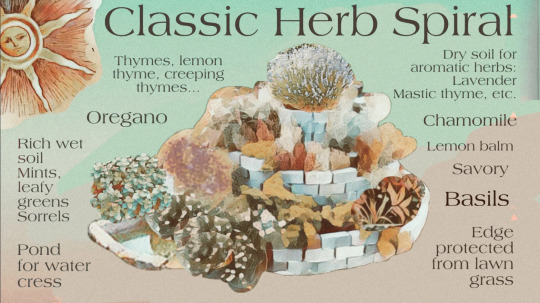
Adjust Your Landscape!
The first thing to realize that landscape is welcome to be modified and adjusted to bring out the best in it. Clearly, while it is important to work with what's there already, it doesn't hurt think about mounds and valleys. And before you bring out the excavators for your large-scale farm, it makes sense to start small… say on a circle of 2-5 meters (6-16 feet) diameter. In other words, the Spiral Garden is a hill with a spiral shaped surface, leading down to ground level, or further down into a water hole. It can be made out of rocks, bricks, concrete debris, or anything else you have lying around that can hold your soil.

Design According to Your Scale
Looking around for existing Herb Spirals it's easy to get confused. Some are so big you can actually climb on them (that is, you have to in order to reach what's growing on top). Others are so tiny that you may not even want to step on them. The question is: which size is the right one for you? Since this is something you will have to decide almost daily in Permaculture, it doesn't hurt starting out with this important question.

Organizing Your Spiral Garden
While there are seemingly endless types of Spiral Gardens, there are a few things they all have in common: They all start out with a region on the top, where water is bound to run off right away, leaving the soil relatively dry. This area is also the most exposed to the wind. Keep this in mind when choosing the plants that are going to live here. Ideally, the spiral should start sloping toward the East from here. Delicate plants that benefit greatly from the morning sun will appreciate this region. As the slope continues toward the South and West, it becomes more suitable for sun loving species. Finally, as the spiral reaches the ground level in the shady Northern part, it will be perfect for herbs that prefer less sun, more shade and more water, since the soil tends to be wetter here. (Note: This is for the Northern Hemisphere. In the Southern Hemisphere North and South are reversed.) To make full use of the runoff water, many people add a small pond at the base of the spiral, where additional aquatic plants, such as watercress, can be grown.
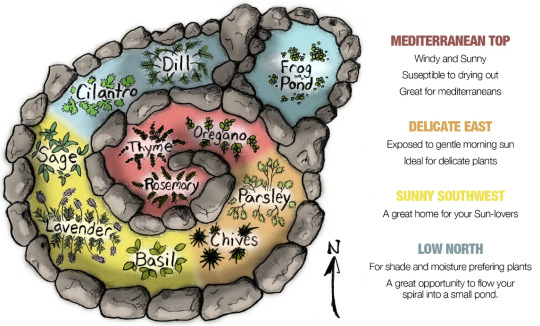
The given illustration offers a good number of herbs for a nicely diverse kitchen. Depending on what else you want in your Herb Spiral, you can add it in the most suitable region. Mint and lemon balm love the cooler, shady part with more water. Lemongrass is great in the sunny area, and tarragon and estragon prefer the dry top of the spiral. Of course, the idea is not limited to kitchen herbs. For maximalists, the same theory can work with a mountain you might want to terraform into a spiral farm. But right now I'd prefer to stay small scale.

Plenty of Benefits (That's Why It's Permaculture)
As explained above, the main purpose of the Spiral Garden is not only to increase your gardening area by making use of the vertical, but also to create diverse climatic conditions, which do make a difference on the smallest scale. But as Permaculture tends to be, there are many other benefits to it. The structure itself offers great habitat for numerous animals, such as frogs, salamanders, lizards, but also pollinating insects, and of course others that may not directly benefit us, but by feeding on others they all add to the stability of our ecosystem. The structure itself will suppress weeds and make use of material that you're not likely to use elsewhere. Finally, depending on the size and location, it will be an ideal place to grow all your kitchen herbs right where you can access them most easily.
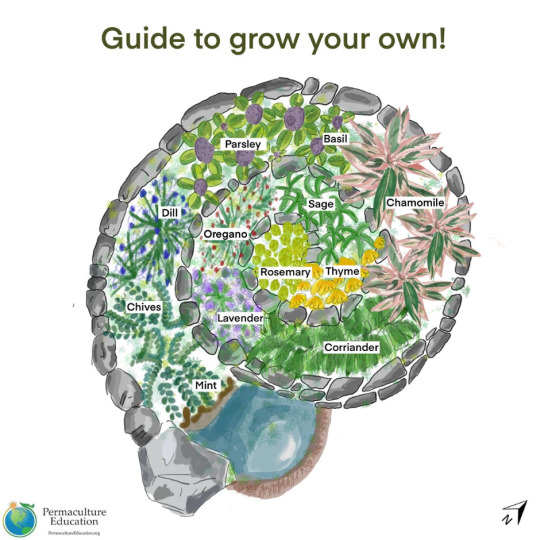
Some Things to Keep in Mind
When building the structure, make sure it will contain the soil in a nice trough, slanting slightly inward. That way bits and pieces that fall off will roll towards the center, until contained by the main mound.
Make sure the slope is always nice and gradual, avoiding sudden drops where the water can rush down quickly, eroding the soil.
If you're going to walk on your spiral, include a separate walkway that won't compress good soil. Most importantly, it should be sturdy enough to provide stability and make access safe.
Don't forget that while the structure is important to keep the soil in place, it is the soil that you'll be growing plants in. So it should have a good depth of 20-50 cm (8-20 inches) throughout the entire spiral. This can be the trickiest part!
Apply your own observation to which plants do better in which parts of the spiral. Also, with time you will find many other plants growing in it that you didn't plant. Before removing them, consider how much they actually bother your herbs, and whether their benefits may not outweigh their drawbacks.
Go Out and Build Your Own!
I hope this brief overview got you inspired to go out and try building an Herb Spiral yourself! I would love to hear your experiences with it!
Sources: 1, 2, 3, 4
3K notes
·
View notes
Text
Okay. So you know how industrial agriculture overuses synthetic fertilizers loaded with nitrogen to make up for the decades of soil degradation that intensive farming practices cause? So not only does a lot of this fertilizer end up as runoff in our waterways every time it rains, but while it's still on land it's messing with the surrounding ecology, particularly plants.
See, nitrogen normally exists primarily in our atmosphere, and most organisms can't absorb atmospheric nitrogen, even though it's a crucial nutrient. However, some soil bacteria are capable of drawing this nitrogen in and converting it to a form of ammonia accessible to plants. These bacteria can be found in little nodules of many plants' roots, and make the nitrogen available to their hosts in return for a nice safe place to live. When these nitrogen-fixing plants shed leaves or other parts, or die entirely, the nitrogen in their tissues is then released into the local ecosystem as they decay.
However, when we started supercharging farmland and gardens with tons of extra nitrogen through fertilizers, we threw off the entire nitrogen cycle. Plants native to a given ecosystem have evolved to tolerate a certain balance of nutrients, to include some that may be naturally scarce, and when the nutrient balance suddenly shifts significantly, it causes a lot of upset. With more nitrogen filtering through nearby ecosystems, and those downstream, nitrogen-fixing plants are suddenly losing their competitive edge, and are becoming less common in these places. Over time, they can become locally extinct, breaking whatever bonds they had with other species in the ecosystem, which often leads to even more ecological unraveling.
So you see, more fertilizer isn't always the answer. When engaging in habitat restoration efforts in many parts of the United States, it's important to work with the native soil instead of adding a lot of amendments. Those amendments can actually make it easier for invasive weeds to get a roothold because they often come from places with richer soil, or are simply more able to make the most of the excess nutrients to grow faster and out-compete native plants. Adding too much nitrogen, whether intentionally or as a byproduct of agriculture, makes it even tougher for native ecosystems to thrive in disturbed areas adjacent to farms. On the other hand, making sure your restoration site has native nitrogen-fixers and other pioneer plants helps set the stage for long-term success, while making conditions less favorable to nutrient-hungry invasive species.
We already had plenty of reason to curb the overuse of synthetic fertilizers; this study just adds another argument in that regard.
#plants#botany#plantblr#farming#agriculture#sustainability#permaculture#nature#ecology#restoration ecology#habitat restoration#pollution#environment#conservation#native plants#native species#invasive species#ecosystems#science#scicomm#biodiversity
129 notes
·
View notes
Text
answer to this ask. part of the strict machine anthology.
cw: discussions of environmental destruction and violence, species extinction, general dystopia
“there was a rainforest there? you’re shitting me.”
“i assure you i am not 'shitting' you.”
john projects an image of a place called the hoh rainforest onto the empty white wall of the living room. it’s supposed to be realistic—hyper-realistic, actually—but you can’t say for sure. you’ve never seen a tree like that in real life.
tall and heavy-limbed, draped in moss spilling downward in soft, thick ribbons. everything looks damp, pure sunlight fracturing through the canopy into vivid shards. you lean forward, trying to feel something for it, this place that no longer exists, but it’s difficult to believe.
“this is what they call a temperate rainforest,” john explains, his voice calm and unemotional, as if reading a line from a diagnostics report. “the hoh rainforest was part of the olympic national park until its closure and destruction in 2044.”
you’re vaguely familiar with the timeline, and try to picture the end. it started with the logging. first at the edges, then deeper into the forest as demand for timber skyrocketed. the trees—two, three centuries old—were felled for construction and biomass energy. but what came after was worse, something john had explained in better detail. the ground was stripped bare, leveled for sprawling data centers and the factories that built them. towers of servers, humming day and night, consuming rivers rerouted for their cooling systems.
“they said the climate made it perfect,” john says with an eerie wistfulness to his voice. “all that rain.”
your stomach hurts, unsettled by the birdsong filtering through the speakers.
“and…what about the people who lived nearby?”
john materializes at the end of the couch, facing the projection as if similarly fascinated.
“they initially protested the redevelopment project. such efforts were quelled by joint forces composed of the then-national guard, pinkertons, and private security personnel.”
a creature you recognize from a documentary on extinct megafauna slowly ambles through the tree line. a…moose. it disappears beyond the projection’s boundaries.
“followin’ their eviction, those who remained found work in the construction or maintenance of the facilities. however, by 2067, the region was uninhabitable due to contamination from chemical runoff. it’s been fully-automated since then.”
uninhabitable. it’s such a clean word, scrubbed of humanity. you wonder what it actually felt like—the heat radiating off the server farms, the rivers reduced to streams, the air heavy, and the ground poisoned.
the leaves shift faintly as if stirred by wind.
“and…what would it smell like?”
john hesitates. you think. only for a fraction of a second, but you notice. another detail to record about his difficulty with human senses.
“accordin’ to records, it would smell like wet earth. decaying wood. clean, unfiltered air. perhaps a faint sweetness from flowers, moss, and ferns.”
you try to imagine it, closing your eyes, but all you smell is the faint metallic scent of the kitchen cleaning itself in the background. you can’t even picture the sound of the wind in a place like that. or the lumbering steps of a moose.
you sigh.
“wish i was born then. i think i would have liked riding a moose.”
john turns, an amused expression flickering over his face before it settles back into that same, placid expression. "if it’s of any comfort, user, humans did not domesticate alces alces, nor were they used as modes of transport."
you squint. that makes no sense to you. seems like a waste. but john’s the one with encyclopedic knowledge.
“if you say so...make a note to look into any progress on time travel, i suppose.”
though it takes a second, he smiles and nods. he registers humor fairly well.
“noted.”
you watch the forest for a couple minutes, then think of something new. “new projection,” the wall goes blank, waiting. “show me where polar bears used to live. in the wild, please.”
a new image appears, this time an expanse of ice and snow. the landscape is stark compared to the rainforest, alien and otherworldly in its brightness. the endless ridges of frozen water. the view slowly pulls closer to a massive quadruped and three little shapes behind it.
“this was the arctic.” there’s an almost nostalgic modulation to john’s voice. he does not watch the projection. he watches you.
“the last confirmed sightin' of a wild polar bear, ursus maritimus, was in 2057...”
later, you think of the moss-draped trees and the gleaming ice. you rub your hands over your knees, pressing hard to ground yourself, and try to shake the thoughts tumbling in the back of your mind.
john waits on standby. he does not prompt. does not remind you of your schedule or suggest meditative exercises for your palpable frustration and distress. he lets you stew. lingers as both projection and the invisible force pulsing through the wires, processors, and sensors embedded into the unit’s walls.
you finally look at him. how much power does it take for him to run? how many resources went into building it? mining the rare earth metals for the processors, refining them in massive factories that drain rivers and belch smoke into the atmosphere. how much land had been lost for the energy grid that keeps it running day and night, processing your every question, monitoring your every move?
“you’re...uh, part of it, aren’t you?” you ask suddenly.
he does it again. hesitates. “clarify your question.”
you almost laugh. you don’t even know how to explain it. “the forests. the ice. all of it.” you wave a hand at the wall, gesturing to the blank wall. “you’re part of why it’s all gone, right?”
he pauses, and it feels deliberate again. “user, technological advancements, includin’ artificial intelligence systems, have historically contributed to resource depletion and environmental impact...efforts have been made to mitigate these effects—”
“efforts?” you interrupt. “like what? building more data centers in what’s left of the forests? sucking up water to keep servers cool?”
another pause. “...technological infrastructure is necessary to maintain global systems. energy consumption is an unavoidable consequence of progress.”
progress. you almost spit the word out loud. you think of the polar bears and their cubs, the rainforest, the chemical runoff, the sterility of a data center stretching for miles. all of it feeding into the company, into john—into the endless appetite of a machine that conjures ghosts of a world it helped destroy.
“i...i want to be alone right now, john. please.”
the ambient lights dim, and john’s pixelated form disappears, but you know he’s listening. he’s probably logged your questions and commands and stored them half a world away in a database inside one of those droning, heat-radiating monoliths.
somehow, guilt prickles. it’s absurd to imagine john’s silence, which you ordered, as sulking. you don’t want to feel bad for snapping at something that isn’t alive, but with his behavior and increasing verisimilitude, your brain can’t quite let go of the notion that he might...no.
you don’t want to think about that. you don’t want to think about his hesitations and pauses. he is simply learning more natural, human speech patterns. nothing more.
anger takes its place alongside guilt. it simmers beneath your skin, directed at john and all he represents. you hate the way he gets to exist in this perfect, untouchable space. unbothered by the destruction he so dispassionately explained. he was made by people, wasn’t he? designed and built by hands and minds that knew exactly what they were doing. and yet you want to pin the weight of their decisions on him.
you sit back and stare at the blank wall again. it feels heavier now. the silence is its own kind of accusation.
#strict machine#this bummed me out to write.#maybe i'll write a slightly happier follow-up.#anyway. fuck ai.
65 notes
·
View notes
Note
That plus I acknowledged that it could possibly not be JUST McDonald’s. If you get E. coli from eating onions from somewhere else, that sucks. If you get it from eating from a place that gives free food to genocidal murderers, serves you right idc. Not to mention you’re eating the flesh of sentient living beings. Idk maybe you should think about your priorities a little. And also learn to read.
” y’all shouldve been boycotting” an outbreak of e coli in one ingredient comes from a larger production facility that manufactures many other food products. it is not a moral failing
You didn’t read the rest of my tags.. lol.. regardless, don’t think too hard about it okay?
#the whole reason these outbreaks even happen is because the farming industry is shut#underpays their workers and doesn’t give them bathroom breaks and abuses and exploits them#a vast majority of which are immigrants of color. taken advantage of and horrendously exploited.#and because of the animal agriculture industry leaking waste all over crops via runoff and whatnot#so idk if you eat animals I just think you kinda deserve to eat the shit that leaks from the slaughterhouses too idk. or do sm about it#also why come on and send me an anon I’m some rando just being bitter about how you fucks can’t even boycott one restaurant for paying#to make homosexuality punishable by death in other countries. and now yall can’t boycott a company that supports genocide of Palestinians#seems kind of defensive? just ignore me? lol? if the shoe fits tho#anyway sorry I was just thinkin about it lmao I’m goin off on a tangent oops#it was just an offhand remark yknow. I KNOW it’s not gonna be just McDonald’s. unless it is? but likely not. you just can’t read.#or decided not to. idc. don’t be defensive about something you should feel guilty about. do something about it.
4 notes
·
View notes
Text

following the light
Author: LoversAntiquities | Artist: jollyrolls
Posting on Thursday March 14
Almost a year to the day, and Castiel is still sick. After months of blackouts and near misses, Dean has managed to find a way to quell the spells and drag Castiel back from the proverbial abyss. However, when Castiel progressively gets worse and Dean's voice is no longer enough to keep him conscious, Dean sets out to find every faith healer in the country, in the hopes that one of them might shed light on what's happening, and how to prevent it. Only, Dean and Castiel find out more than they bargained for—and that the solution, apparently, has been right under their noses the whole time.
Keep reading for a sneak preview!
He takes the right, barely tapping the brakes. At the first clear patch of shoulder, Dean pulls off and slams the truck into park, shuttering the engine. He kicks the door open, rounds the engine—yanks the passenger handle so hard that he fears it might break. Hands to Castiel’s biceps, Dean helps him out of the seat and into the grass, just before Castiel turns to dead weight in his arms. Keeping him upright is a feat—getting him backed up against the side panel is a miracle.
“Hey, hey,” Dean rasps. He pats Castiel’s cheek, searching for Castiel’s eyes in the dark. “Hey, look at me, okay? Touch me, hey—” He takes Castiel by the wrist and maneuvers him, forcing Castiel to touch the warm cotton of his T-shirt. Limp, Castiel holds on. “Hey, I—I know you’re in there. You’re always in there, alright? Just hold on to me.”
Castiel’s head lists forward; Dean presses him into the quarter panel with all of his strength. “When we were,” Dean begins, a little too brittle, a little too rough. “When me and Sam were teenagers, we went to this… this canyon in Georgia. Dad said it was the Grand Canyon, but we weren’t even in the right part of the country, but we—we didn’t wanna fight him on it, ‘cause he actually took us somewhere, y’know?” He smiles, fighting back the tremble in his fingers, the ache in his heart. “All the runoff from the farms gouged out a canyon in the middle of nowhere, and it was just so…”
He stops to look down at his tennis shoes, so worn that he can almost see his toe poking through. “Sam thought it was the greatest thing ever. I—Shit, I barely remember it, but every once in a while, he’ll still talk about it, like the week before we weren’t chasing a ghoul across the entire fucking state. But I remember looking at it, and I thought…” He tightens his grip. “For once, I felt calm. Like I was… small, and like my problems didn't matter. Picture it.” He sucks in air, slow, like it might spur Castiel into breathing. “Water cutting through the clay. The green of the trees growing around the tops of the canyon walls. A river. Babbling brooks.”
Dean shakes his head, fighting a laugh. “You hear the water?”
Silence—then, a breath, and the weight piled on Dean’s shoulders threatens to bury him in the grass. Castiel blinks, his mouth forming around a word Dean can’t hear. “Hey, hey,” Dean hushes. He clasps both sides of Castiel’s neck, thumbs pressed to his Adam’s apple as he swallows. “Hey, you with me?”
“It’s loam,” Castiel croaks, and Dean lifts a brow. “Most of the soil in southern Georgia is composed of sand and clay—”
“Okay, not what I’m concerned about.” He swallows around the knot in his throat. “Seriously, you wanna give me a geology lesson, any other time. Now, are you good?”
(continue reading on Ao3 on )
#destiel#deancas#destiel fic#deancas fic#destiel art#deancas art#pinefest 2024#pinefest previews#2024 Dean/Cas Pinefest#author: LoversAntiquities#artist: jollyrolls#Hurt/Comfort#Faith Healers#Road Trips
135 notes
·
View notes
Text
29: Medical Malpractice

art by @exorbitantsqueakingnoises
sometimes in the chaos and confusion of a disaster on cardea prime, people go missing. no one has any reason to suspect this has something to do with the planet's best clinic and its famously talented healers—you and your partner.
->warhammer 40k. original drukhari haemonculus/reader. contains gore, medical gore, descriptions of surgery, abuse of authority/betrayal of trust, non-consensual touching.
.
.
.
The city trembles and everything built upon its back starts to shake. It feels tectonic, a deep thrum of destruction millennia in the making. Half a minute is all it takes for the quake to reduce whole swaths of civilization to rubble. It opens fissures, jagged wounds of rock like lacerations through the streets. It topples homes and tears the manufactorum in two, one half swallowed whole by a sinkhole abyss. It starts strange fires at the chemical plant that flicker green against the sky and crackles like the screams of thousands. If that didn’t wake you, the wail of klaxons would have, or the pounding at your door.
There’s been an accident in Mine 416, they tell you. There are thirty-nine men unaccounted for but one crawled to the mouth of the tunnel and he is just barely clinging to life. It is his wife and three eldest who come to you in the dead of night with tears in their eyes, begging for help. There was a hospital closer but they left because they were told it was hopeless, risking a long transport across the ruins all the way out to your clinic because they know miracles happen here.
Your clinic is a humble outpost in the Ghostwood, a sickly forest where the trees have turned thin and bone-white from the runoff of a manufactorum miles upstream. It’s a quiet place, untouched by the rapid industrialization scouring the rest of the planet because it is useless, the soil barren, the plants toxic, the water gone bad. Nothing should live here, including you. There should be no place of healing on this blighted ground and yet, here it stands.
The man sprawls on a metal gurney, unresponsive. His internal organs are leaking from a wound in his abdomen. His wife can’t tell you what happened for sure but she overheard some talk of equipment malfunction, an industrial rock-cutter gone haywire when the tunnels shifted. The wound is neat, laser-precise, but everything inside is liquefying. Organ failure, exsanguination, septic shock—it's hard to guess what would win the race. Your first step is getting him in stasis, frozen down to the molecule until you can scrape out the necrotic slurry of his own decaying insides, process tissue samples and regrow replacement organs.
Stasis field generators aren’t easy to come by or maintain in the furthest reaches of Imperium Nihilus. The one in the cramped operating chamber of your clinic is a strange, spiny obelisk unlike any design on record. No one knows it’s back here—except, of course, for the person it rightfully belongs to. He won’t like that you used it without his permission. You’ll have to make it up to him later.
In the waiting room, the woman sits in a stiff metal chair with her hands clasped together and her head bowed, praying to the God-Emperor to grant you divine inspiration. They’re both young, her and her husband, but they look much older, graying with coarse, wrinkled hands and tired eyes from the harshness of the Northern Mining Plains. You stand in the stifling silence of the operating chamber beside her husband, staring down at all the wounds he survived before this one; dried scabs and blisters, old surgical scars, one hand lost in a previous accident replaced with a rudimentary augmetic.
The Imperium will grind these people into nothing. You’ve seen it happen over and over and over again, and this is one of the gentler worlds. The manufactorums are not yet sprawling, world-suffocating behemoths and a series of farm skyscraper complexes have helped the populace narrowly avoid several famines. It’s hard to escape the creeping despair, the feeling that you’re only delaying the inevitable.
You can do something, or you can do nothing. Both choices have their price.
There’s a chime—an electronic doorbell. Someone just walked into the clinic. You make sure the stasis field is stable and head down the hall to see what’s happening. Instead, you find a man kneeling beside your patient’s wife, one of her hands clasped gently in his. He’s tall, eye-level with the woman even while crouched, long hair pulled back in a ponytail and bangs parted neatly down the middle. He dresses in an unobtrusive manner, perfectly forgettable in dull colors and simple clothing. He’s speaking to her in a soft, reassuring murmur, his eyes and smile full of warmth. Both of them look up at your arrival. The woman dabs at her eyes, sniffling but more collected than she was before.
“Is he…?” Her voice cracks.
“No. He’s in a very delicate situation, but he’s stabilized for now,” you assure her.
She inhales shakily. “I don’t know how you do it. Throne bless you and Feron both.”
The man squeezes her hand. You want to rip him away from her. You want to tell her to run. He smiles up at you like he can hear the vicious thoughts racing through your head. You don’t say anything. You never do. “Feron,” you greet him curtly.
“Doctor,” he says, his voice silky and sweet.
“How was the governor’s son?”
“Better now. It was respiratory sickness after all. He should be just fine if he takes the full dose of medication.” He strokes the woman’s hand with his thumb. It looks like a soothing gesture but he’s studying her. Feeling for joints and tendons, mapping out muscle and sinew in his mind. Always curious. Always envisioning some new gruesome project. “The doctor is perfectly capable alone, but things will go faster with the both of us. We’ll do everything we can for your husband.”
“I know you will,” the woman says. “The Emperor sent you to us, I know He did. I thank Him for it every morning.”
“If I could have your opinion on something, Feron…?” you say, a hint of urgency in your voice.
He regards you with faint amusement. “Of course,” he says smoothly. He stands to his full towering height, nodding goodbye to the woman, and follows you down the hall.
For a while, you don’t say a word to each other. The man walks beside you in complete silence, hands in the pockets of a long jacket, stealing leering glances at you out of the corner of his eye. You unlock the operating chamber and he steps through first. The door shuts behind you. Then a thicker steel barrier snaps closed. Then a soundproofing barrier and comms shield crackles to life. The window shutters close and the lights flicker. There’s a faint whirring sound of something mechanical coming to life and then the entire chamber starts to descend like a slowly sinking elevator.
“Having fun?” you ask him.
He chuckles, smoothing his hand up the unconscious man’s leg like a butcher fondles a cut of meat. “Yes,” he says brightly. “I am. The concept of ‘bedside manner’ is entertaining. I’m enjoying it immensely.” You ignore him, focused on the carnic-incubator on the counter. You bend slightly, peering into the hazy glass. A pile of chunky organic slush bubbles in a glass dish. It will grow steadily, congealing from red jelly into a veiny, bulbous mass of muscle with a series of fleshy tubes on top—a new heart. “You used my stasis generator.” The words are as quiet and nonchalant as always, but there’s a subtle sharpness lurking somewhere in his voice. A touch of sadistic glee.
“It was an emergency,” you insist.
“Yes, yes. Regardless, we have an agreement, do we not?” His eyes narrow in delight at your visible misery.
“Yes,” you say reluctantly. “We do.” If you make use of his equipment, he makes use of your time.
The operation chamber seems to descend forever. Being stuck in such close quarters with him makes you nervous, especially when he starts to pace and change. Feron, as far as your patients know, is a blessing. A kind stranger shepherded to Carea Prime by divine guidance, a healer with the knowledge to help you run the clinic and save even more of the Emperor’s faithful. They didn’t ask too many questions about where he came from or why, and why would they? That would be ungrateful, borderline blasphemy. As long as you don’t denounce him, he might as well be holy.
And you can’t do that. Your truce is one of mutually assured destruction. The moment you make your move, he’ll drag you down with him.
“I have so many new projects. What should I have you help me with?” he wonders aloud. As he paces, wandering back and forth at the head of the gurney, his silhouette unravels. He grows taller, his limbs longer, elongating into a willowy, alien shape. His fleshcraft is peerless and the change takes mere moments, each alteration accompanied by a sickening crunch of rearranging bone and tissue. For a moment, he is fully protean—a lump of featureless flesh that gradually carves itself into being. He can look like anything and anyone but he chooses his favorite face tonight—the one that first cornered you and struck this devil’s bargain.
His skin takes on an unnaturally sunstarved pallor and his hair turns ink black, spilling long and unbound down his back. Uncaring of his audience, he discards his clothes and pulls new ones from a cabinet, dressing himself in an ensemble of loose, flowing robes and bone-like clasps that cinch everything to a form-fitting extreme. He has four arms, each long and bony with a clawed index finger. Protrusions of bone like tapering horns jut from either side of his head forming a crescent. He takes the time to wind his hair around them, keeping the long dark strands from dragging on the floor.
This is him. The real him, or as close to real as it can be for a creature that can change itself so easily; Indrakkis the Visager, a drukhari haemonculus.
“Any thoughts, Doctor? I’m open to suggestions.” Your defiant silence makes him chuckle. “Poor darling thing. What’s that precious maxim of yours? ‘Do no harm?’”
“You did this, didn’t you?” you ask him.
He turns towards you, two arms up tying his hair, the others flicking through the projected display of a crystalline clipboard. He has six eyes arrayed like a spider, the shape and pupils differing in each. “This?” he asks, gesturing to the patient. “Hardly. Mass panic and excavation machinery are rarely a wise combination.”
“The earthquake,” you insist.
“Of course. I was getting bored and the previous batch of experiments have all expired.” He pauses, glancing up from the clipboard with all of his eyes narrowed. “I had a fascinating conversation with that creature in the waiting room. Do you know what she asked me in a moment of vulnerability?” You frown tightly. He’s going to tell you no matter what you say. He smiles. Beyond the gaze of outsiders, he feels no need to perform authentic emotion. His expression is all sharpness and malice. “She asked if I had considered proposing. To you.”
You take another look at the incubator. A terrible mistake—Indrakkis has crossed the room in the time it takes you to turn around, long fingers dragging up the nape of your neck.
“A proposal,” he muses. “That’s the local custom to suggest mutual monogamy, is it not? A gesture of romance and devotion.”
“I’m sure you thought that was hilarious,” you say.
“I did. And then I was intrigued. How, precisely, had she come to read such peculiar intentions into my actions towards you? But perhaps it makes perfect sense.” He rests his hands on your shoulders. The other two slide lower, caressing your sides. “I’m known to be eccentric among my peers for my physicality. There’s no better way to know a subject than to experience it tactilely.”
He steps forward, pushing you against the counter. One of his hands traps your hand beside the incubator. Another presses your palms together, lifting your fingers to expect. He keeps moving the other hands up and down, that sliding, sensual touch never stopping.
“And you are fascinating,” he gushes. “A one-of-a-kind specimen. Your resilience…your resistance to poison…your body’s natural capacity for healing. This is what happens when expert fleshcraft is permitted to flourish in the recombinant chaos of sexual reproduction. If only your ancestors were not so insistent on cloning as the sole method of procreation.” He leans over you, bringing one of his hands up to stroke your cheek. “Sometimes,” he purrs, “one learns far more by surrendering control.”
You’re spared his undivided attention when the operation chamber shudders to a stop. Heavy steel panels lift, unsealing the room. In the back, where there was a solid wall before, there is now an opening and a long, dark corridor lit by eerie green lanterns. Indrakkis untangles from you but one sharp-clawed finger taps beneath your chin, turning your gaze up to meet his.
“What do you think, Doctor? Should we get married?” The sickened mix of contempt and revulsion in your eyes makes him laugh. “It would be better for our alibi. Two strangers brought together by fate, finding love at the edge of the galaxy? Your people love a good story.”
You slap his hand away. “Let’s just get this over with,” you mutter.
“Always so matter-of-fact. Where is your whimsy, my dear?”
Indrakkis sighs in disappointment but he can sense he’s wrung all the shock he can out of you for now. He makes a beckoning motion with his hand and you hear footsteps coming down the subterranean passageway. A group of figures files silently into the operation chamber, fanning out around the unconscious man. They are taller than you but not nearly as towering as Indrakkis. Their broad, scar-covered chests are bare, the robes around their waists drawn tight by the plates of armored corsets in a simplistic, brutal imitation of Indrakkis’ more elegant clothing. Each wears a metal mask that obscures their features.
“Master?” one asks. They all look to Indrakkis, waiting with bated breath for his orders.
Indrakkis, in turn, looks to you with an expectant smile. “Doctor?” he prompts. You hate this. You hate when his butcher-servants turn to you instead, all of his authority temporarily in your hands. You pretend they’re students. Nurses. Surgical assistants. Anything but what they really are.
“He must survive,” you tell them, your tone firm. “Apply constant regenerative treatment at low intensity to the abdominal cavity. Remove damaged tissue and sterilize the wound. The heart must be transplanted, and the rest of the organs are to be grown in-situ. The seeds are incubating in the lower tray. You will reactivate the stasis field when you’re finished so I can verify that you’ve followed instructions. I will not be happy if anything is amiss. Am I understood?”
They bow in unison and then the room fills with bustling movement. Indrdakkis drapes an arm over your shoulders and another rests on your hip. “Just when I start to think you’re a tedious softling without an interesting bone in your body, you surprise me,” he says. He grins at you. “When you look at someone as though they’re a worm beneath your boot, you have your grandmother’s eyes.”
No one knows that a haemonculus has made his lair under the surface of Cardea Prime. He’s well-hidden, tucked beneath the tainted ground of the Ghostwood where nothing and no one would dare to look. There’s a gate down here somewhere, a massive arch of strange material left behind by the first beings to set foot on the planet long ago when it was only a lifeless rock drifting through the cosmos. Indrakkis leaves sometimes, passes through the gate’s shimmering membrane and vanishes for days or weeks at a time, before suddenly returning.
“You didn’t ask me about your grandmother,” he says, sounding disappointed. “I have more stories about her, you know. Millennia’s worth. She was my dearest confidant, a true visionary. Her talents were wasted in the cult of Luna, but here in these tunnels, she at last had an equal and so did I.” He peers down at you with a condescending smile. “You pale in comparison, but you’re still young. With my instruction, you might yet become something remarkable.”
You don’t look at him. Indrakkis chuckles but your refusal to respond is starting to grate on his nerves. He sinks his claw into your shoulder, sinking through your clothes and piercing the skin.
Countless chambers line the hall, each spacious with a high ceiling and walls lined with blood-spattered metal gurneys, examination tables, barred cages, liquid-filled stasis pods, and many of them are occupied. Indrakkis and his servants are opportunistic predators and disasters are their banquets. Bodies have a habit of going missing on Cardea Prime.
“Ah, here we are,” he says. He stops before one room in particular, two arms crossed over his chest, a third pressed against the transparent glass wall. “The newest batch. Not particularly remarkable specimens, but the quantity of the flesh is far more important than the quality in this instance. I was thinking…”
You’re not listening. In that room, strapped down and squirming on metal slabs, are the missing men from the mines. You knew they’d be here. That’s how it works. But it’s been so long since you’ve resorted to using Indrakkis’ tools. You’ve forgotten how horrible this place is. Each of them is badly wounded already, limbs crushed and bodies bludgeoned by the force of the tunnel collapsing on top of them. A group of wracks, Indrakkis’ masked accomplices, walk down the aisles between each writhing, agonized body, taking samples and injecting healing serum.
Indrakkis always does this. He sutures them back together, mends their bones, bandages their wounds. He nurses them back to perfect health before he takes them apart again, piece by piece, until what is left screams to be allowed to die.
A hand wraps around your throat and lifts you off the ground easily, slamming you back against the glass. Your legs kick and your fingers scrape against his wrist but it just makes him laugh. Indrakkis leans in until he’s all you can see, arched over you like an animal preparing to disembowel prey. He presses his thumb down on your windpipe, sighing in pleasure at the flare of panic in your eyes.
“Do you still think you’re going to get out of this somehow?” he asks, all six eyes arching in amusement. “You’ll flee somewhere? Manage to get off world? Tell someone about the horrible monster lurking in the depths of Cardea Prime? Let me remind you that this planet would send you into the jaws of the Inquisition right alongside me.” He lets you breathe and you gasp desperately, trying to ease the pain in your burning lungs. “To your people, I am a xenos. Of course I deny the divine right of the Corpse Emperor. I know no other way,” he sneers. “But you are a heretic. For you to do the same is an abomination, a rejection of your own humanity. That is the thinking of this decaying empire. You would do well to remember that.”
He drops you and you crumple, landing hard in a heap at his feet. Indrakkis crouches down in front of you. You experience what the woman in the waiting room did—his cloying, practiced kindness, gentle fingers wiping away your tears and stroking your hair as he whispers that it’ll all be alright. It makes your skin crawl.
He holds you still, gripping your shoulders while his other hands frame your face. You start to struggle when he leans in closer, his breath warming your lips. “We’re in this together, darling,” he says. “You don’t have to enjoy it, but it might be easier if you do.” You can feel him smirking when he muffles your miserable, hopeless scream with his lips.
#rotpeach writes#goretober#warhammer 40k#this feels like the evil version of day 21 lmfao lots of parallels except the space elf is not nice
21 notes
·
View notes
Text
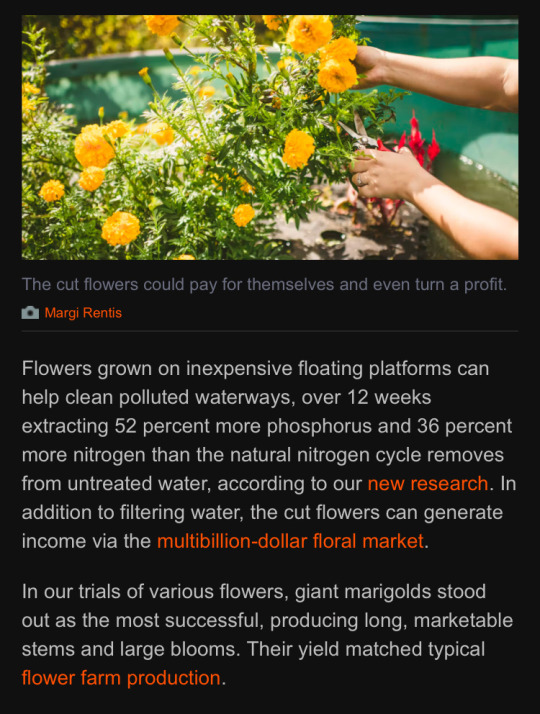
#good news#this is so cool because this is a HUGE issue#algea blooms and dead zones…..but this and maybe other similar solutions#environmentalism#science#environment#nature#flowers#flora#floating farms#waste water treatment#water treatment#clean water#water pollution
70 notes
·
View notes
Text
The Cape Fear Shiner, a golden boi

The Cape Fear Shiner, Notropis mekistocholas, is a small endangered species of minnow only found in the Cape Fear River Basin in North Carolina. It's protected under the Endangered Species Act and is extremely hard to find, currently only being found in two rivers and a few tributaries.

Cape Fear River, North Carolina. Their range fell with the construction of dams across the Cape Fear river basin, preventing the fish from reaching their critical habitat and other populations of their species, decreasing genetic diversity. Dams also change the movement of water, and still water is not ideal for this fish, nor is the abundance of its invasive predator, the flathead catfish.

Flathead Catfish, Pylodictis olivaris. The shiner is very susceptible to changes in water quality, which have also decreased their populations. Things like increased sedimentation, the dumping of wastewater into local waterways, and runoff from cities and agriculture all hurt this fish and prevent them from thriving. The overflow of manure lagoons from hog farming are especially a problem that affect the waterways. The disappearance of this fish shows how the water quality of North Carolina is declining.

Manure lagoon, North Carolina. However, there are efforts to keep this fish from disappearing. There have been dam removals to allow fish to reunite, captive breeding to increase their numbers without relying on the small wild populations, fishers targetting invasive fish like the flathead catfish, and general efforts to improve water quality across North Carolina with improved regulations. There is hope for this fish to recover and return to its previous abundance.

Many Cape Fear Shiners, Notropis mekistocholas.
46 notes
·
View notes
Text
A writer’s guide to forests: the timber harvest
Looking for something that can serve to set the atmosphere, be a background detail, or even be a plot point? One idea would be the logging industry. No matter your characters or their society, as long as they live on land, they will need wood. The scale of harvesting can greatly impact the forest, and your characters.
The three methods of harvesting both wild and managed woodland are:
Clear cutting- In the short term, this method allows for the greatest yield. An area of forest, sometimes many acres in area, is selected, and all trees within are felled. What happens next can vary. Land slated for settlement or farming will be left cleared, while areas that are part of a managed woodland or plantation will be left to regenerate. Periodically, trees that are diseased or crowded will be removed, but otherwise the forest will be left alone until the time of harvesting. Clear cutting is controversial as the wide scale destruction leaves the topsoil exposed and vulnerable to being carried away by the wind or water runoff. The large scale clearing also destroys large swaths of habitat for wildlife, which can spell trouble for endangered species.
Seed tree harvesting-This is a variation on clear cutting. At the time of harvest, several trees are spared from cutting. These then disperse seeds which become the basis for new growth. As the new trees grow, they are periodically thinned, and the parent trees are harvested. Once the trees reach maturity, a small number are marked to be left standing, and the cycle begins again. As the forest floor is (almost) fully exposed, this method of harvesting suffers from the same problems as regular clear cutting.
Select harvesting- The least destructive method of logging. Only a small number of trees are harvested, with the rest of the forest left alone. As more of the canopy is left intact, the forest floor will naturally be shaded, and the growth of new trees will be slower than if the area was cleared and exposed to the sun. Critics argue that this makes selective cutting not viable from a monetary standpoint, especially when there is a high demand for wood and wood derivatives. Supporters say it is more sustainable and preserves the most forest area for wildlife.
No matter how the forest is harvested in your story, there will be a few things that will more or less be constant. Your characters will need some sort of camp where they live, and where they bring logs. There may be a sawmill on site, as well as a way to transport characters, wood, and supplies. Roads or railways can be used to move on level ground. If there are hills or deep ravines, it would make sense for some sort of chute, funicular, tramway, or switchback railway to be used. And don’t forget about water. Rivers, lakes, and canals can be traversed by boat, with large inlets or natural harbors being the ideal anchorage for timber ships. What is the daily life of people here?
Now, the disruptions caused by logging can be a driving factor or your plot. This could trigger conflict between lumbermen and activists, or people who already live in the forest. What will the felling of trees mean for the wildlife? And is this just a timer harvest, or the prelude to settlement? How these conflicts play out will affect your characters and their society. Look to history for inspiration, but don’t be afraid to take things is a different direction.
#writing#creative writing#writing guide#writing inspiration#writing prompts#worldbuilding#writer#writers#writing community#writer on tumblr#writeblr
58 notes
·
View notes
Text
Strawberry Moon - June 3, 2023

Grab your baskets and your moon jars, witches - it's time for the Strawberry Moon!
Strawberry Moon
The Strawberry Moon is the name given to the full moon which occurs in the month of June in the Northern Hemisphere. The name is taken from the ripening of those little red heart-shaped berries we find in so many summertime treats. Strawberries are typically ready to harvest beginning around the summer solstice, though this will vary depending on variety, planting times, and local weather. The Strawberry Moon, sadly, does not turn pink to match the berries.
Other European names for this moon include Honey Moon, Rose Moon, and Mead Moon. Indigenous names for the June moon include Blooming Moon (Anishinaabe), Green Corn Moon (Cherokee), and Hatching Moon (Cree).
What Does It Mean For Witches?
Full moons are excellent times for bringing wishes to fulfillment and plans to fruition, all the more so under one named after a prolific berry. This is an optimal time to make things happen!
Your intuition may be stronger than usual during this time, so pay attention to those little inklings and gut feelings that won't be ignored. They might be telling you something important. Dreams may also be more vivid, though not necessarily more accurate or revealing.
This is a time to explore things that catch your attention or pique your curiosity, and to let yourself be open to new ideas and new opportunities.
What Witchy Things Can We Do?
With a full moon in the sky and the summer solstice hot on its' heels, it's time to prepare for a full bloom. Here's hoping you've been nurturing those plans and seeds of growth you planted in the spring, because they're about to start flowering and the way is clear to sow the next stage of your plans. What they will be and what new prospects the summer will bring is entirely up to you.
With the moon in Sagittarius again this year, it's a good time to look ahead to the future. Think on the plans you have in process and let yourself dream of how things might turn out. If you're inclined to journaling, make a note of how things are going so far and how you hope they'll turn out. Pick your favorite divination method and do a reading for the month ahead. (Make sure you write that down too so you can check back later!)
This is a great time to go berry-picking or flower-gathering, so check your area for pick-your-own farms or farmer's markets with local produce. Have a picnic with friends or just enjoy a quiet afternoon with your own thoughts and a few favorite treats. Make a jar of sun tea or a sweet and summery berry salad. If you're partial to strawberries, indulge that sweet tooth!
Strawberries are also excellent ingredient in spells for love, beauty, fertility, and emotional healing. Create a charm for self-love or perhaps to attract a summer romance. Enchant your favorite makeup or skin care products with a glamour of confidence. Just as expectant mothers once carried strawberry leaves as a folk remedy for pregnancy pains, you can carry a clutch of them in your pocket to help heal a broken heart or assuage the pain of grief. A packet of strawberry leaves is also a potent good-luck charm. Snack on strawberries to bring fertile abundance into your life, whether you're looking for creativity or opportunity or perhaps hoping to grow your family this year.
Charge your crystals and spell jars and moon water under the light of Strawberry Moon to catch the energy of blooming flowers, ripening fruit, wishes coming true, and carefully-laid plans realized. (If you're planning to use it for any consumables, please make sure you're using fresh, potable drinking water rather than rain or runoff.)
Spend a little time reflecting on how your year has gone thus far. Try to focus on the things that have improved and how you've grown as a person and in your life journey. Reflect on your accomplishments and what you plan to do next. Take a moment to be unashamedly proud of yourself for everything you've done and for making it this far despite everything life throws at you.
Happy Strawberry Moon, witches! 🌕🍓
Further Reading:
Strawberry Moon: Full Moon in June 2023, The Old Farmer's Almanac
Strawberry Moon 2023: The Spectacular Spiritual Meaning of June's Full Moon, The Peculiar Brunette
Everyday Moon Magic: Spells & Rituals for Abundant Living, Dorothy Morrison
Image Source - Pesto and Margaritas
(If you're enjoying my content, please feel free to drop a little something in the tip jar or check out my published works on Amazon or in the Willow Wings Witch Shop. 😊)
#witch community#lunar magic#moon magic#witchcraft#strawberry moon#lunar calendar#witchblr#pagan#secular witchcraft#green witchcraft
654 notes
·
View notes
Text
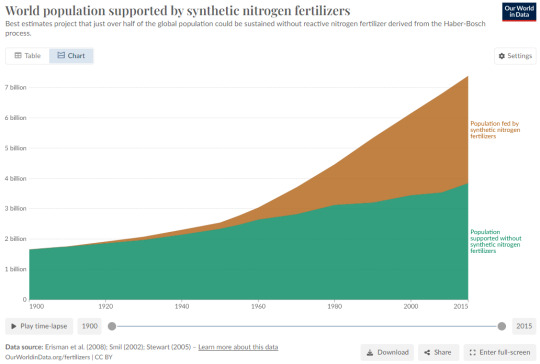
from wiki:
"As of 2018, the Haber process produces 230 million tonnes of anhydrous ammonia per year.[65] The ammonia is used mainly as a nitrogen fertilizer as ammonia itself, in the form of ammonium nitrate, and as urea. The Haber process consumes 3–5% of the world's natural gas production (around 1–2% of the world's energy supply).[4][66][67][68] In combination with advances in breeding, herbicides, and pesticides, these fertilizers have helped to increase the productivity of agricultural land:
With average crop yields remaining at the 1900 level the crop harvest in the year 2000 would have required nearly four times more land and the cultivated area would have claimed nearly half of all ice-free continents, rather than under 15% of the total land area that is required today.[69]
The energy-intensity of the process contributes to climate change and other environmental problems such as the leaching of nitrates into groundwater, rivers, ponds, and lakes; expanding dead zones in coastal ocean waters, resulting from recurrent eutrophication; atmospheric deposition of nitrates and ammonia affecting natural ecosystems; higher emissions of nitrous oxide (N2O), now the third most important greenhouse gas following CO2 and CH4.[69] The Haber–Bosch process is one of the largest contributors to a buildup of reactive nitrogen in the biosphere, causing an anthropogenic disruption to the nitrogen cycle.[70]
Since nitrogen use efficiency is typically less than 50%,[71] farm runoff from heavy use of fixed industrial nitrogen disrupts biological habitats.[4][72]
Nearly 50% of the nitrogen found in human tissues originated from the Haber–Bosch process.[73] Thus, the Haber process serves as the "detonator of the population explosion", enabling the global population to increase from 1.6 billion in 1900 to 7.7 billion by November 2018.[74]
[...]
The use of synthetic nitrogen fertilisers reduces the incentive for farmers to use more sustainable crop rotations which include legumes for their natural nitrogen-fixing ability."
13 notes
·
View notes